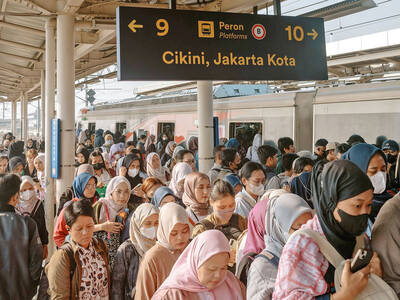The fallout from this week’s deadly suicide bombing in Kabul has further splintered Afghanistan’s relations with neighboring Pakistan and set back the US-led military campaign to stabilize the region before international troops leave at the end of 2014.
The attack that killed 56 people and wounded more than 160 others outside a Shiite shrine highlighted a marked decline in security in the Afghan capital over the past year. Afghan forces, who have been in charge of security in Kabul for more than a year, have had successes in foiling plots and minimizing casualties, but insurgents increasingly slip through checkpoints and conduct complex assaults.
Ties between Afghanistan and Pakistan were already frayed when Afghan President Hamid Karzai on Wednesday blamed a Pakistan-based extremist group for the bombing at the shrine. Pakistan challenged Karzai to provide hard evidence.
The evidence, Karzai suggested, was that a man claiming to be from Lashkar-e-Jhangvi al-Alami, a Pakistan-based splinter group of Lashkar-e-Jhangvi that has carried out attacks against Shiite Muslims in Pakistan, called various media outlets on Tuesday to claim responsibility for the Kabul bombing and a nearly simultaneous attack that killed four Shiites in the northern Afghan city of Mazar-e-Sharif.
“We are investigating this issue and we are going to talk to the Pakistani government about it,” Karzai said, standing outside a Kabul hospital after visiting victims of the bombing.
Until now, the decade-long Afghan war has largely been spared sectarian violence, where civilians are targeted simply for their membership in a particular religious group. Tuesday’s attack suggests that at least some militant groups may have shifted tactics, taking aim at ethnic minorities such as the Hazara who are largely Shiite and support the Afghan government and its Western partners.
However, there was some doubt that a little-known splinter group could carry out the coordinated bombings in Afghanistan, where neither it nor the main Lashkar-e-Jhangvi has a history of conducting operations.
Pakistani Foreign Ministry spokesman Abdul Basit said Pakistan would encourage Kabul to share any evidence it has that the group was responsible.
Later, he sent a text message to reporters, condemning the attack on the shrine.
“The government and the people of Pakistan are grieved and stand by the brotherly people of Afghanistan at this difficult time,” he said.
Pakistani military spokesman General Athar Abbas dismissed any suggestions that Lashkar-e-Jhangvi has links to the country’s intelligence agencies or that the government was not doing everything it could to quash the group.
“Lashkar-e-Janghvi has declared war on the security forces in Pakistan,” he said. He said the group has been implicated in some of the worst attacks on Pakistani security forces.
“They are being hunted down,” he said.
Karzai began to sharpen his criticism of Pakistan several months ago after a suicide bomber, pretending to be a peace emissary from the Taliban, assassinated former Afghan president Burhanuddin Rabbani, who was leading efforts to broker a deal with the insurgency.
Afghan officials said the Sept. 20 assassination was planned on the southern outskirts of Quetta, the Pakistani city where key Taliban leaders are based. Afghan officials shared evidence with Pakistani officials, but Afghan-Pakistan cooperation on the investigation into Rabbani’s murder so far has been tenuous.
Previous attacks in Kabul have been blamed on the Haqqani militant network, which is based in Afghanistan and is thought to have ties to the Taliban, al-Qaida and Pakistan’s spy agency.
To the mourners burying the dead in Kabul and planting red flags in dusty cemeteries to mark the fresh graves, achieving stability in Afghanistan is more important than which militant group was responsible for the latest attacks.
Mohaqeq Zada, a member of the Shiite council in Kabul, said the bombing showed no one can count on the government for protection.
“There have been so many attacks, even against government officials, and still they can’t stop these things,” Zada said.

FRUSTRATIONS: One in seven youths in China and Indonesia are unemployed, and many in the region are stuck in low-productivity jobs, the World Bank said Young people across Asia are struggling to find good jobs, with many stuck in low-productivity work that the World Bank said could strain social stability as frustrations fuel a global wave of youth-led protests. The bank highlighted a persistent gap between younger and more experienced workers across several Asian economies in a regional economic update released yesterday, noting that one in seven young people in China and Indonesia are unemployed. The share of people now vulnerable to falling into poverty is now larger than the middle class in most countries, it said. “The employment rate is generally high, but the young struggle to

STEPPING UP: Diminished US polar science presence mean opportunities for the UK and other countries, although China or Russia might also fill that gap, a researcher said The UK’s flagship polar research vessel is to head to Antarctica next week to help advance dozens of climate change-linked science projects, as Western nations spearhead studies there while the US withdraws. The RRS Sir David Attenborough, a state-of-the-art ship named after the renowned British naturalist, would aid research on everything from “hunting underwater tsunamis” to tracking glacier melt and whale populations. Operated by the British Antarctic Survey (BAS), the country’s polar research institute, the 15,000-tonne icebreaker — boasting a helipad, and various laboratories and gadgetry — is pivotal to the UK’s efforts to assess climate change’s impact there. “The saying goes

ENERGY SHIFT: A report by Ember suggests it is possible for the world to wean off polluting sources of power, such as coal and gas, even as demand for electricity surges Worldwide solar and wind power generation has outpaced electricity demand this year, and for the first time on record, renewable energies combined generated more power than coal, a new analysis said. Global solar generation grew by a record 31 percent in the first half of the year, while wind generation grew 7.7 percent, according to the report by the energy think tank Ember, which was released after midnight yesterday. Solar and wind generation combined grew by more than 400 terawatt hours, which was more than the increase in overall global demand during the same period, it said. The findings suggest it is

TICKING CLOCK: A path to a budget agreement was still possible, the president’s office said, as a debate on reversing an increase of the pension age carries on French President Emmanuel Macron yesterday was racing to find a new prime minister within a two-day deadline after the resignation of outgoing French Prime Minister Sebastien Lecornu tipped the country deeper into political crisis. The presidency late on Wednesday said that Macron would name a new prime minister within 48 hours, indicating that the appointment would come by this evening at the latest. Lecornu told French television in an interview that he expected a new prime minister to be named — rather than early legislative elections or Macron’s resignation — to resolve the crisis. The developments were the latest twists in three tumultuous